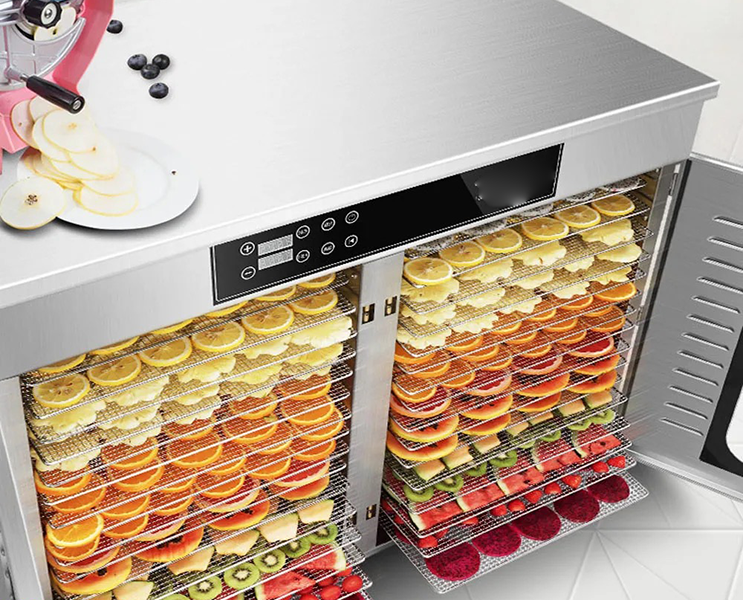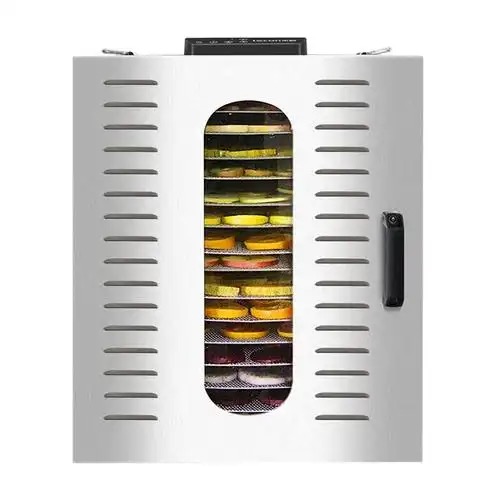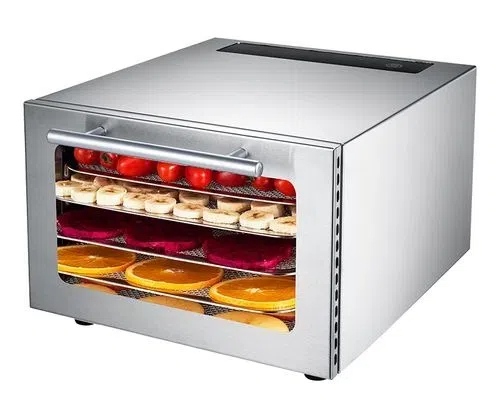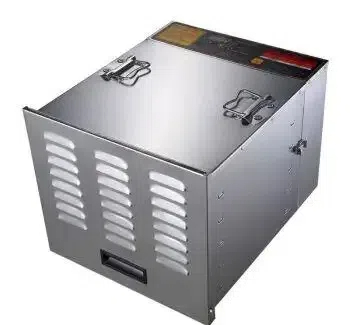
Content Menu
● Introduction
● Understanding Food Dehydrators
>> How Heat Pump Dehydrators Work
>> How Condenser Dehydrators Work
● Key Differences Between Heat Pump and Condenser Dryers
>> Energy Efficiency
>> Drying Temperature
>> Drying Time
● Applications of Food Dehydrators
>> Fruit Drying Process
>> Vegetable Drying Process
● Choosing the Right Food Dehydrator
>> Factors Influencing Your Choice
● Innovations in Food Dehydration Technology
>> Environmental Considerations
● Additional Insights into Food Dehydration Techniques
>> Benefits of Dried Foods
>> Common Mistakes When Using Food Dehydrators
>> Future Trends in Food Dehydration
● Conclusion
● Frequently Asked Questions (FAQs)
>> 1. What are the main advantages of using a heat pump dryer?
>> 2. Can I use a condenser dryer for drying fruits?
>> 3. How long does it take to dry foods using a heat pump dryer?
>> 4. Are there any maintenance requirements for these dehydrators?
>> 5. Which type of dryer is more cost-effective in the long run?
Introduction
Food drying is an essential process in food preservation, enhancing flavor, and extending shelf life. Among the various methods available, food dehydrators play a crucial role in efficiently removing moisture from food items. This article delves into the intricacies of food dehydrators, particularly focusing on the differences between heat pump and condenser dryers, and how these technologies apply to food drying.

Understanding Food Dehydrators
Food dehydrators are appliances designed to remove moisture from food, thereby inhibiting the growth of bacteria, yeasts, and molds. This process not only preserves the food but also concentrates flavors and nutrients. There are several types of food dehydrators, including:
- Heat Pump Dehydrators: These use a heat pump system to transfer heat from the environment to the food, making them energy-efficient.
- Condenser Dehydrators: These operate by heating air and passing it through the food, with moisture collected in a tank.
How Heat Pump Dehydrators Work
Heat pump dehydrators utilize a refrigeration cycle to transfer heat. They draw in air from the environment, compress it to raise its temperature, and then circulate this warm air around the food. As the air absorbs moisture from the food, it cools down and is condensed back into water, which is then removed.
How Condenser Dehydrators Work
Condenser dehydrators function by heating air to a higher temperature and then circulating this hot air around the food. The moisture-laden air is passed through a heat exchanger where it cools down, causing moisture to condense into water. This water is collected in a tank for disposal.
Key Differences Between Heat Pump and Condenser Dryers
Understanding the differences between heat pump and condenser dryers can help manufacturers and consumers make informed decisions about which technology best suits their needs.
| Feature | Heat Pump Dryer | Condenser Dryer |
| Energy Efficiency | Highly energy-efficient | Less energy-efficient compared to heat pump |
| Drying Temperature | Operates at lower temperatures (30-50°C) | Operates at higher temperatures (70-75°C) |
| Drying Time | Longer drying times | Faster drying times |
| Moisture Removal | Moisture is condensed and recycled | Moisture is collected in a tank |
| Cost | Generally more expensive upfront | Usually less expensive |
Energy Efficiency
Heat pump dryers are known for their energy efficiency as they recycle heat within the system. This contrasts with condenser dryers that consume more energy due to higher operating temperatures. For businesses looking to reduce operational costs, investing in a heat pump dryer can lead to significant savings over time.
Drying Temperature
The drying temperature significantly affects both the efficiency and quality of the dried product. Heat pump dryers operate at lower temperatures, which can be beneficial for preserving delicate flavors and nutrients in foods. This is particularly important when drying herbs or fruits that can lose their essential oils and flavors at high temperatures.

Drying Time
While condenser dryers may offer faster drying times due to higher temperatures, this can sometimes lead to over-drying or loss of flavor. Heat pump dryers may take longer but often yield better quality dried products. For example, when drying vegetables like tomatoes or peppers, slower drying at lower temperatures helps retain color and taste.
Applications of Food Dehydrators
Food dehydrators are versatile machines used in various applications:
- Fruit Drying: Ideal for producing dried fruits like apples, bananas, and apricots.
- Vegetable Drying: Effective for preserving vegetables such as tomatoes, peppers, and carrots.
- Herb Drying: Great for drying herbs like basil, thyme, and oregano.
- Meat Drying: Used for making jerky or preserving meats.
- Snack Production: Many manufacturers use dehydrators to create healthy snacks like vegetable chips or fruit leathers.
Fruit Drying Process
The fruit drying process typically involves washing and slicing fruits into uniform pieces to ensure even drying. Fruits are then placed in the dehydrator at optimal temperatures for several hours until they reach the desired dryness.
Vegetable Drying Process
Vegetable drying requires blanching before dehydration to preserve color and nutrients. Blanching involves briefly boiling vegetables before plunging them into ice water. After blanching, vegetables are sliced and arranged in the dehydrator for drying.
Choosing the Right Food Dehydrator
When selecting a food dehydrator, consider factors such as:
1. Capacity: Depending on your production needs.
2. Energy Consumption: Evaluate long-term operational costs.
3. Drying Technology: Choose between heat pump or condenser based on your specific requirements.
4. Ease of Use: Look for features like digital controls or automatic shut-off.
5. Maintenance Requirements: Consider how easy it is to clean and maintain.
Factors Influencing Your Choice
- Type of Food: If you primarily dry fruits or delicate herbs, a heat pump dryer may be more suitable due to its lower temperature settings.
- Volume of Production: For large-scale operations requiring quick turnaround times, a condenser dryer might be preferred despite its higher energy consumption.
- Budget Constraints: While heat pump dryers are more efficient long-term, their initial cost can be a barrier for smaller businesses.
Innovations in Food Dehydration Technology
The field of food dehydration has seen significant advancements over recent years. New technologies focus on improving efficiency and product quality:
- Smart Controls: Many modern dehydrators come equipped with smart technology that allows users to monitor and control settings via smartphone apps.
- Enhanced Airflow Systems: Improved airflow designs ensure even drying across all trays.
- Energy Recovery Systems: Some advanced models incorporate systems that recover wasted heat energy during operation.
Environmental Considerations
As sustainability becomes increasingly important in manufacturing processes, many companies are looking for ways to minimize their environmental impact. Heat pump dryers are often viewed as more eco-friendly due to their lower energy consumption compared to traditional methods.
Additional Insights into Food Dehydration Techniques
Benefits of Dried Foods
Dried foods offer numerous benefits beyond preservation:
- Nutrient Retention: Properly dried foods retain most vitamins and minerals compared to canned or frozen options.
- Lightweight & Portable: Dried foods are easy to transport due to reduced weight and volume.
- Versatility in Cooking: Dried fruits can be rehydrated for use in baking or cooking while retaining flavor.
Common Mistakes When Using Food Dehydrators
To maximize results with any type of dehydrator:
1. Overloading Trays: Avoid overcrowding trays as this can impede airflow leading to uneven drying.
2. Inconsistent Slicing: Ensure uniformity in slicing foods so they dry evenly.
3. Ignoring Guidelines: Each type of food has specific temperature settings; adhering strictly ensures optimal results.
Future Trends in Food Dehydration
As consumer preferences shift towards health-conscious eating habits:
- There's an increasing demand for organic dried products without additives or preservatives.
- Innovations such as freeze-drying are gaining popularity due to their ability to retain texture while removing moisture efficiently.
Conclusion
In conclusion, understanding the differences between heat pump and condenser dryers is vital for anyone involved in food processing or preservation. Heat pump dryers offer superior energy efficiency and better product quality but may require a higher initial investment. On the other hand, condenser dryers provide quicker drying times at a lower cost but may compromise on energy efficiency and product quality.
As you consider investing in a food dehydrator for your business or personal use, weigh these factors carefully to choose the right technology that meets your needs.

Frequently Asked Questions (FAQs)
1. What are the main advantages of using a heat pump dryer?
Heat pump dryers are highly energy-efficient and operate at lower temperatures, preserving more nutrients and flavors in dried foods.
2. Can I use a condenser dryer for drying fruits?
Yes, condenser dryers can be used for drying fruits; however, they may not preserve flavors as effectively as heat pump dryers due to higher operating temperatures.
3. How long does it take to dry foods using a heat pump dryer?
The drying time varies depending on the type of food being dried but generally takes longer than condenser dryers due to lower temperatures.
4. Are there any maintenance requirements for these dehydrators?
Both types require regular cleaning of their components; however, heat pump dryers may need more attention due to their complex systems.
5. Which type of dryer is more cost-effective in the long run?
While heat pump dryers have a higher upfront cost, their energy efficiency often leads to lower operational costs over time compared to condenser dryers.












